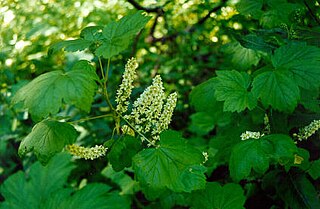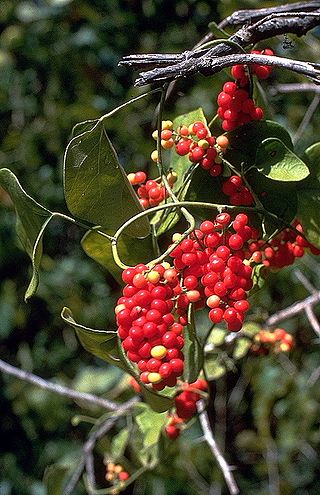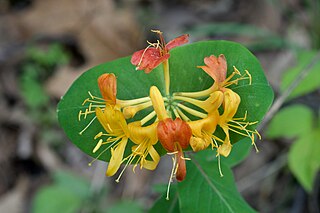
Campsis radicans, the trumpet vine, yellow trumpet vine, or trumpet creeper, is a species of flowering plant in the family Bignoniaceae, native to eastern North America, and naturalized elsewhere. Growing to 10 metres, it is a vigorous, deciduous woody vine, notable for its showy trumpet-shaped flowers. It inhabits woodlands and riverbanks, and is also a popular garden plant.

Gelsemium sempervirens is a twining vine in the family Gelsemiaceae, native to subtropical and tropical America: Honduras, Guatemala, Belize, Mexico, and southeastern and south-central United States. It has a number of common names including yellow jessamine or confederate jessamine or jasmine, Carolina jasmine or jessamine, evening trumpetflower, gelsemium and woodbine.

Gelsemium is an Asian and North American genus of flowering plants belonging to family Gelsemiaceae. The genus contains three species of shrubs to straggling or twining climbers. Two species are native to North America, and one to China and Southeast Asia.

Berchemia scandens, commonly called Alabama supplejack, is a species of climbing plant in the buckthorn family. It is native to the central and southern parts of the United States. It is found in a wide variety of habitats, including swamps, bottomlands, riparian banks, and upland calcareous areas.

Rubus deliciosus is a North American species of flowering plant in the rose family Rosaceae, native to the United States. Common names include the delicious raspberry, boulder raspberry, Rocky Mountain raspberry or snowy bramble.

Rubus ursinus is a North American species of blackberry or dewberry, known by the common names California blackberry, California dewberry, Douglas berry, Pacific blackberry, Pacific dewberry and trailing blackberry.

Erigeron strigosus is a species of flowering plant in the family Asteraceae known by the common names prairie fleabane, common eastern fleabane, and daisy fleabane.

Tamaulipa is a genus of flowering plants in the tribe Eupatorieae within the family Asteraceae. It is monotypic, being represented by the single species Tamaulipa azurea, commonly known as blue boneset. The generic name refers to the State of Tamaulipas in northeastern Mexico, and to the Tamaulipan mezquital scrubland, which covers much of the state. The species also occurs in the extreme southern part of Texas in the United States. It is a climbing shrub or non-twining vine that grows to about 2 to 3 m and has bluish or blue lavender flowers.

Vitis tiliifolia is a New World liana in the grape family commonly known as Caribbean grape. Other names include West Indian grape, water vine, Agrá and Bejuco de Agua and water tie-tie and water-wise.

Ribes hudsonianum is a North American species of currant, known by the common name northern black currant.

Prunus caroliniana, known as the Carolina laurelcherry, Carolina cherry laurel, Carolina cherry, or Cherry laurel, is a small evergreen flowering tree native to the lowlands of Southeastern United States, from North Carolina south to Florida and westward to central Texas. The species also has escaped into the wild in a few places in California.

Cocculus carolinus, commonly called the Carolina coralbead, or snailseed, or Margil's Vine, is a perennial vine of the moonseed family (Cocculus). It is native to North America, where it is found in Mexico and in several states in the United States from the Southeast to the Midwest.

Smilax laurifolia is a species of flowering plant in the greenbrier family known by the common names laurel greenbrier, laurelleaf greenbrier, bamboo vine, and blaspheme vine. It is native to the southeastern United States, where it occurs along the Gulf and Atlantic coastal plains from Texas to New Jersey, the range extending inland to Arkansas, Oklahoma, and Tennessee. It also occurs in Cuba and the Bahamas.

Smilax auriculata is a North American plant species native to the Bahamas, the Turks & Caicos Islands, and the southeastern United States. Common names include earleaf greenbrier and wild-bamboo, despite the fact that it is not closely related to bamboo. It is reported from Florida, Georgia, North and South Carolina, Alabama, Mississippi, and Louisiana. It grows on coastal sand dunes and in sun-lit locations in sandy woodlands at elevations of less than 100 m.
Smilax pumila, the sarsaparilla vine, is a North American species of plants native to the southeastern United States from eastern Texas to South Carolina.
Smilax walteri, common names coral greenbrier, red-berried greenbrier or red-berried bamboo, is a North American species of plant found only in the United States. It is native to coastal plains in the south-central, southeastern, and east-central parts of the country, from eastern Texas to New Jersey.

Lonicera dioica is a vine in the honeysuckle family native to Canada and the eastern and central United States. Lonicera dioica comprises four variations: var. dasygyna, var. dioica, var. douglasii, and var. orientalis.

Lonicera flava is a species of honeysuckle native to the central and eastern United States. It is a woody vine with yellow-orange flowers that are slightly fragrant.

Matelea cynanchoides, commonly called prairie milkvine, is a species of plant in the dogbane family that is native to south-central United States.

















